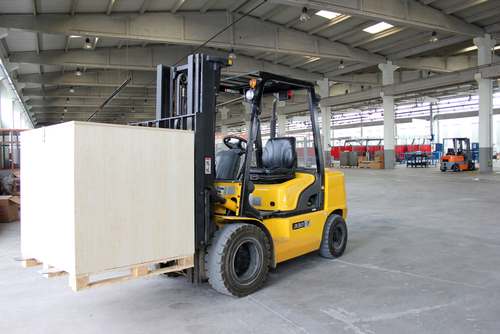Additional Training for Forklift Maintenance Workers
Some topics are specific to forklifts, but other forklift maintenance hazards are covered by different OSHA standards. Employees who are exposed to these hazards while working on forklifts may require additional training under the standards noted by OSHA below:
- Exhaust hazards. Workers should know how to use adequate ventilation to protect themselves against gasoline, diesel, or LPG exhaust (29 CFR 1910.94, Ventilation)
- Hazardous energy. Maintenance workers should keep control of the forklift’s ignition key while they work. Also, they should disconnect the battery before working on the electrical system. Blocking raised parts and elevated equipment are another topic they may need training in (29 CFR 1910.147, Control of Hazardous Energy (Lockout/Tagout)).
- Wheel hazards. Workers who service forklift wheels may need training under 29 CFR 1910.177, Servicing Single-Piece and Multi-Piece Rim Wheels.
- Asbestos. During brake and clutch repairs, workers may be exposed to asbestos (29 CFR 1910.1001, Asbestos).
- Compressed gases. LPG is a compressed gas. Compressed gas hazards are covered under 29 CFR 1910 Subpart H, Hazardous Materials.
- Eye, face, hand, and body hazards. To protect against some chemical exposures, cut and abrasion hazards, and falling object hazards, workers may need PPE (29 CFR 1910 Subpart I, Personal Protective Equipment).
- Fire hazards. Because maintenance work may involve fire hazards, workers should know how to use a fire extinguisher (29 CFR 1910 Subpart L, Fire Protection).
- Welding hazards. If repairs involve welding operations, workers will need training under 29 CFR 1910 Subpart Q, Welding, Cutting and Brazing.
Great news! BLR’s renowned Safety.BLR.com® website now has even more time-saving features. Take our no-cost site tour! Or better yet, try it at no cost or obligation for a full 2 weeks.
Work Locations
OSHA emphasizes that forklift repairs must take place in locations that are specifically designed to perform the necessary tasks safely. Make sure that workers have:
- A location free of fire hazards. OSHA forbids repairing forklifts in hazardous (Class I, II, or III) locations. In particular, repairs to the fuel or ignition system of a forklift may only be made in an area with no uncontrolled fire hazards.
- Emergency equipment. Because forklift repairs can involve fire hazards, fire extinguishers must be provided. Because liquid chemical hazards may be present, emergency eyewashes and showers must also be located in the work area.
OSHA’s forklift training requirements are extensive, and it can be confusing to try to figure out exactly which requirements apply to which workers. Fortunately, BLR® has done a lot of the work for you already.
Ride with Us
Navigate your way through the maze of safety regulations and ever-changing demands of your job to a safer workplace. Safety.BLR.com will provide the road map. And we’ll keep you up to date on all the latest news and views, 24/7, from the comfort and convenience of your own desk.
Whether it’s changes in OSHA requirements, news about innovative safety ideas, guidance for creating effective safety plans, or some other vital safety and health issue, you’ll find it all reported and interpreted for you by our safety experts at Safety.BLR.com.
What’s more, this one-stop safety website is a fantastic resource for safety training materials on just about any topic you can imagine.
Training responsibilities become a snap with the website’s thousands of audio presentations, PowerPoints, prewritten safety meetings, toolbox talks, trainer’s guides, and much, much more. You’ll find training tools on more than 120 safety topics along with plain-English compliance analysis and other resources.
Your one-stop safety management resource, available 24/7. Go here to take a no-cost site tour or here to try it in your own office!
At a time when budget considerations are paramount, what makes more sense than an all-in-one safety training and compliance solution?
And BLR has revamped Safety.BLR.com to meet your needs even better. You’ll be amazed by all the features and functionality of the site. Highlights include:
- Side-by-Side State/Federal Compliance. By placing our state and federal regulatory analysis side by side, you easily see how to fully comply with both governmental entities.
- MSDS Library Expansion. The site now provides an immense library of 3.5 million MSDS and SDS forms, with about 10,000 more added or changed every week. Need one? Just call up the chemical by name, manufacturer, product group, or CAS number, then print it out.
- Newsletter Wizard. If you’ve ever wanted to publish a safety newsletter but felt lacking in editorial skills, this new addition is for you.
- Plan Builder. Select from our library of safety plans, customize them to suit your company’s needs, and assemble them into collections you can save in our personal library.
We’re pretty excited about Safety.BLR.com and all of its enhancements, and we’re eager for you to experience it, too. That’s why we’ve created a complimentary site tour, available here. It takes just 5 minutes.
If you like what you see, you’re invited to try the site at no cost and with no obligation. We’ll even give you a complimentary special report for doing so. Go here to take a 5-minute tour of Safety.BLR.com. It may be just what you’re looking for. |

